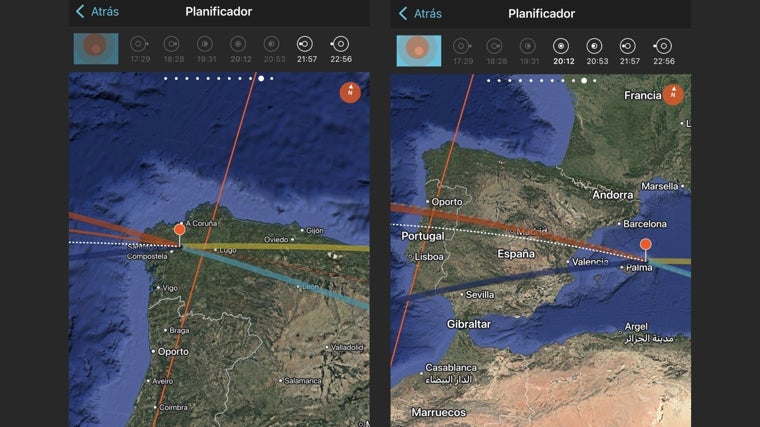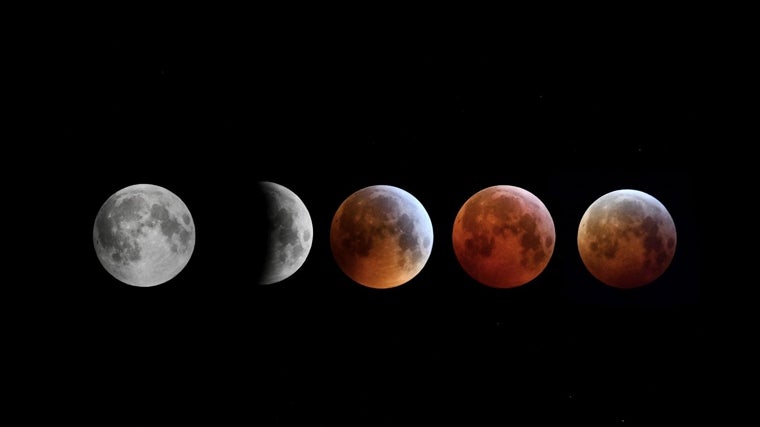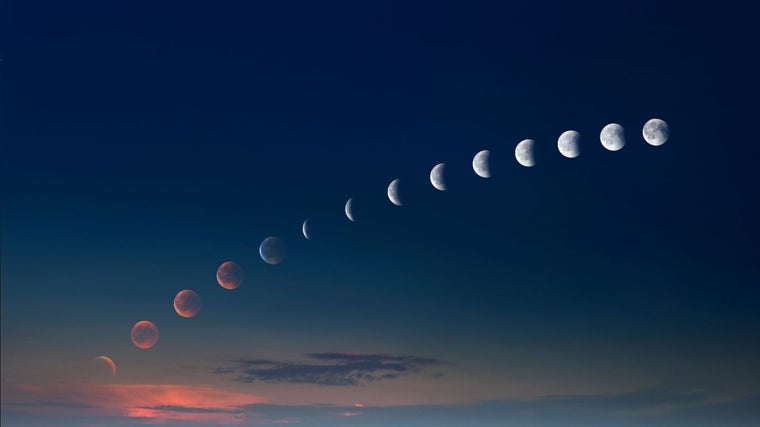Total Lunar Eclipse: Guide to Enjoying and Photographing This Sunday's Blood Moon

The Spanish skies are preparing for a unique spectacle: this Sunday, September 7, we will be able to contemplate a total lunar eclipse , a phenomenon that can be observed with the naked eye and poses no risk to your eyesight: just look up at the sky and marvel.
It will also be the last chance to see a total lunar eclipse in our country until December 2028, making this a must-see event. Here we tell you what time to look up, how to make the most of it, and what tips to use if you want to photograph the so-called Blood Moon.
 On the left is the line dividing the map where totality will be visible. Above the two photos are the moonrise times in the Balearic Islands and Galicia.
photopills
On the left is the line dividing the map where totality will be visible. Above the two photos are the moonrise times in the Balearic Islands and Galicia.
photopills
Eclipses are already very special events, but this one has one characteristic that stands out from the rest: the Moon will rise over the horizon in the full phase of totality; that is, completely tinged with red under the Earth's shadow, and that's something all of us photographers who specialize in eclipses lose sleep over.
A lunar eclipse occurs when the Earth comes between the Sun and the Moon, projecting its shadow onto the surface of our satellite and dulling its brightness, but in return also dyeing it a very particular warm tone, giving it the name ' Blood Moon '.
The change to a reddish color is due to the scattering of light in Earth's atmosphere, and varies in hue depending on the amount of dust, clouds, or volcanic ash in the air. It's the same effect that gives sunsets a fiery color, but in the case of a lunar eclipse, it becomes much more dramatic due to the absence of light reflected by the Sun.
The eclipse will last about an hour and a half and will be visible from across the country, although with differences depending on the region.
In most of Spain, the Moon will appear completely eclipsed. In the Balearic Islands, for example, it will rise around 8:12 p.m., during the end of the total phase or umbra. However, in the westernmost locations, it will be partially eclipsed, just as the Earth enters the penumbral zone and we can see our planet's shadow perfectly silhouetted on the lunar disk.
 Phases of the Moon
shutterstock
Phases of the Moon
shutterstock
The further west you are, the fewer minutes of totality you'll be able to enjoy, as the Moon will rise later. In Galicia and the Canary Islands, it will rise around 8:53 PM, when the total phase of the eclipse will already be over. However, it will still be worth seeing: it will be fascinating to watch as it emerges partially eclipsed and gradually "fills out" and returns to its normal shape.
To enjoy it without interruptions, look for a place with a clear horizon to the east-southeast (the less light pollution the better), because although the full moon is usually very bright, during the eclipse its brightness plummets, being obscured by ourselves, which makes the sky darken and offers a magical atmosphere.
 Blood Moon and Barcelona Cathedral
Jessica Rojas
Blood Moon and Barcelona Cathedral
Jessica Rojas
Binoculars or a small telescope are a great extra, allowing you to distinguish the nuances of color and find the object more easily during its first few minutes of visibility.
If you want to locate the moon accurately and in advance, apps like PhotoPills or Stellarium are your best allies: thanks to their augmented reality function, you can 'see' where on the horizon the moon will appear even before it does.
You can capture photos with many different devices (smartphone, digital telescope, camera), and each has its own peculiarities, but there are universal tips that work for all and will make a difference.
The important thing is to be clear about what type of image you want to achieve, because that decision will determine everything else. For example, those with a 200mm or longer telephoto lens must definitely take advantage of the first few minutes when the Moon appears over the horizon, whether it's totally or partially eclipsed. In addition to fulfilling the "Lunar Illusion" or the "ponzo" effect, which are hypotheses that theorize why our satellite appears much larger when it's on the horizon, you can also take advantage of this situation to compose a dreamlike landscape, such as an enormous moon aligned with a medieval castle.
Although you could also achieve unique photographs if you decide to capture that moment with a more common lens like a 24-70 mm, because in that case you can compose a much broader landscape that includes all the phases of the eclipse, and then combine them into a single photograph that shows the passage of time in the sky.
 Lunar eclipse phases
Shutterstock
Lunar eclipse phases
Shutterstock
Another option is to record a video or try a timelapse, a more technical challenge that requires patience and more planning, but allows you to show how the Earth casts its shadow on the moon in a continuous and dynamic manner.
Whatever you choose, there are common technical aspects to keep in mind. Stability is essential: the Moon moves faster than we think, and any vibration ruins sharpness, so a steady tripod and, if possible, a remote shutter release are essential. You'll also need to adjust the exposure, because a normal full Moon can be photographed at fast shutter speeds, around f/8, 1/100 at ISO 500. However, during an eclipse, you'll need to lower the shutter speed to about one second and increase the sensitivity to as much as ISO 4500, with apertures between f/5.6 and f/7 depending on the lens. It's best not to exceed this second of exposure to prevent the satellite's movement from being captured and causing blur in the image.
 Lunar eclipse last March
Jessica Rojas
Lunar eclipse last March
Jessica Rojas
One last tip: play with your surroundings. Take advantage of the Moon's low altitude during the eclipse to include terrestrial elements and create compositions that look like something out of a science fiction movie. And, if you have the time and desire, don't hesitate to keep the camera still throughout the sequence and then combine the shots: seeing the Moon go from a silver glow to a deep red and back again in a single image is a memory hard to beat.
The weather forecast for the night of the eclipse is somewhat more uncertain than usual, with models like Meteoblue predicting 60% shifting cloud cover across much of the country, accompanied by light wind gusts of around 10 km/h. This means there will be areas where the clouds will play hide-and-seek with the Moon, but also periods of clear skies where the phenomenon can be enjoyed. Conditions can vary greatly from region to region, and even from hour to hour, so it's best not to give up at the first opportunity. Sometimes all it takes is an unexpected clearing for the red-tinged Moon to appear in all its splendor, and that's already worth the wait.
ABC.es




